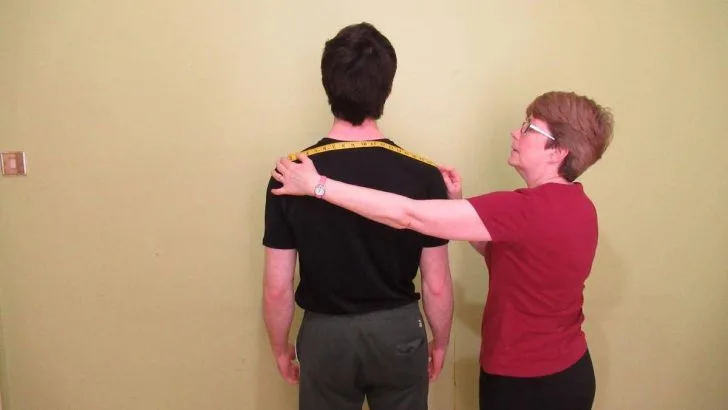If you’re curious about the average shoulder width for males, females, children, and teenagers, then this article is for you.
Drawing on American, European, and Asian anthropometric data that examines thousands of participants, we set out to discover the average shoulder-to-shoulder measurement for humans of various ages, races, and for both men and women.
In our How to measure your shoulders section, we’ll also show you 3 different ways to measure your shoulders so that you can understand your body type and track your fitness progress.
Related Measurement Guides:
- Average male height
- Average height for women
- Average men’s neck size
- Average American male waist size
- Average hip measurement
- Average wrist circumference
- Average chest circumference for a man
- Average forearm measurement
- Average bicep size for a man
- Average calf size for men
- Average male quad-size
What is the average male shoulder width?

What is the average male shoulder width? According to American anthropometric data from the Centers for Disease Control and Prevention’s National Health and Nutrition Examination Survey, the average shoulder width for men is 16.2 inches or 41.1 cm.
This data is based on the measurements of 7,476 US men aged 20 and over. [1] The researchers measured the biacromial breadth (the distance between each acromion process on the shoulder blade) of the participants using a large sliding bone caliper.
Here is a breakdown of the average man’s shoulder width by age group.
Men aged 20-29 and 30-39 both had a shoulder width average of 16.3 inches or 41.4 cm.
Males ages 40-49 had a very similar average shoulder length to their younger counterparts (41.3 cm or 16.3 inches).
The average shoulder width of a man aged 50-59 is 16.1 inches or 41 cm. For males aged 60-69, the average shoulder size measurement is slightly smaller at 15.9 inches or 40.5 cm.
Finally, the average shoulder span for men aged 70-79 is 15.6 inches or 39.7 cm, and for men aged 80+, the average shoulder measurement is 15.4 inches or 39 cm.
On a side note, it doesn’t appear that your race or ethnicity affects your shoulder width to any significant extent. Blacks, Whites, and Hispanics all had very similarly sized shoulders.
Other research shows that young Chinese men have 16.7-inch shoulders on average, which is right in line with the US average. [2]
However, it’s unclear whether the authors of this particular study used bi-acromial breadth or whether they measured shoulder width from the back with a tape, which would result in a larger measurement.
What is the average female shoulder width?
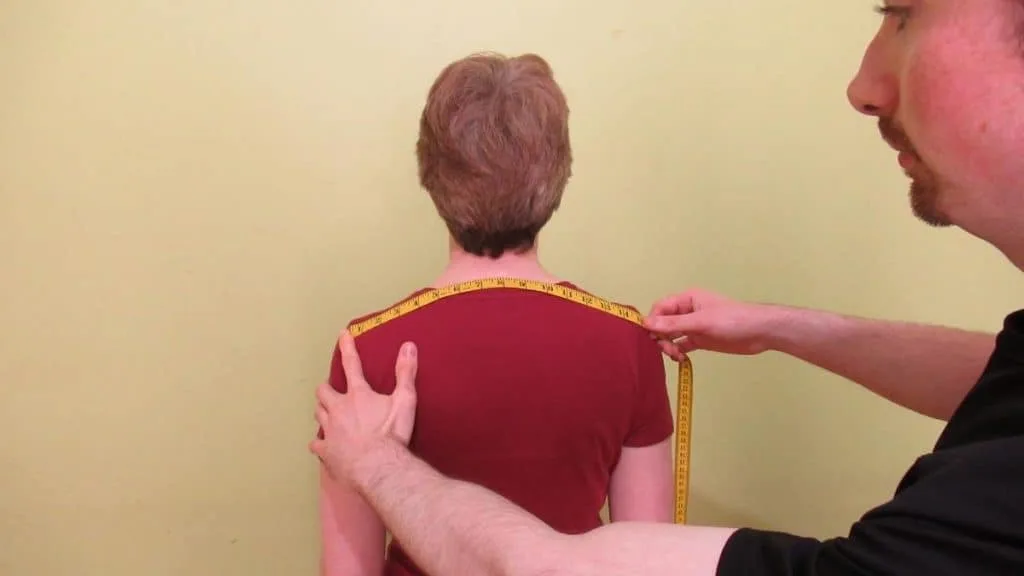
What is the average female shoulder width? According to anthropometric reference data provided by the CDC that measured the biacromial breadth of 8,411 women, the average shoulder width for females is 14.4 inches or 36.7 cm.
The above data is based on all females aged 20 and over. Here’s a breakdown of the average woman’s shoulder width by age for further clarification.
Women aged 20-29 had an across shoulder measurement of 14.5 inches or 36.9 cm, whereas women aged 30-39 had an ever-so-slightly larger shoulder measurement of 14.6 inches or 37 cm.
The average shoulder width for a woman aged 40-49 and 50-59 is 14.5 inches or 36.9 cm.
The average shoulder width of a human female aged 60-69 is 14.3 inches or 36.4 cm. For women aged 70-79, the normal shoulder width was found to be 14.1 inches or 35.7 cm.
Finally, women aged 80+ had a shoulder width average of 13.7 inches or 34.8 cm.
What is the average shoulder width for children?

As one would expect, the average shoulder width for children and teenagers depends greatly on the age and gender of the participant.
For example, male and female 5-year-olds both have an average shoulder width measurement of 9.8 inches or 25 cm.
However, 16-year-old males have a significantly larger shoulder-to-shoulder measurement (15.7 inches or 39.9 cm) than their female counterparts (14.4 inches or 36.7 cm).
It’s interesting to note that the average female shoulder measurement doesn’t increase by any significant amount past age 14. On the other hand, males of the same age keep seeing shoulder width gains until age 17 or 18.
Therefore, the data highlights well the different growth patterns of male and female teenagers. For more information, see the shoulder width size chart below—it gives you the average shoulder measurement for children and teenagers aged 3-19.
How Wide Are Your Shoulders?
- 10 inch shoulders
- 12 inch shoulders
- 13 inch shoulders
- 14 inch shoulders
- 15 inch shoulders
- 16 inch shoulders
- 17 inch shoulders
- 18 inch shoulders
- 19 inch shoulders
- 20 inch shoulders
- 21 inch shoulders
- 22 inch shoulders
- 23 inch shoulders
- 24 inch shoulders
- 25 inch shoulders
- 30 inch shoulders
What is the average shoulder width in the UK?
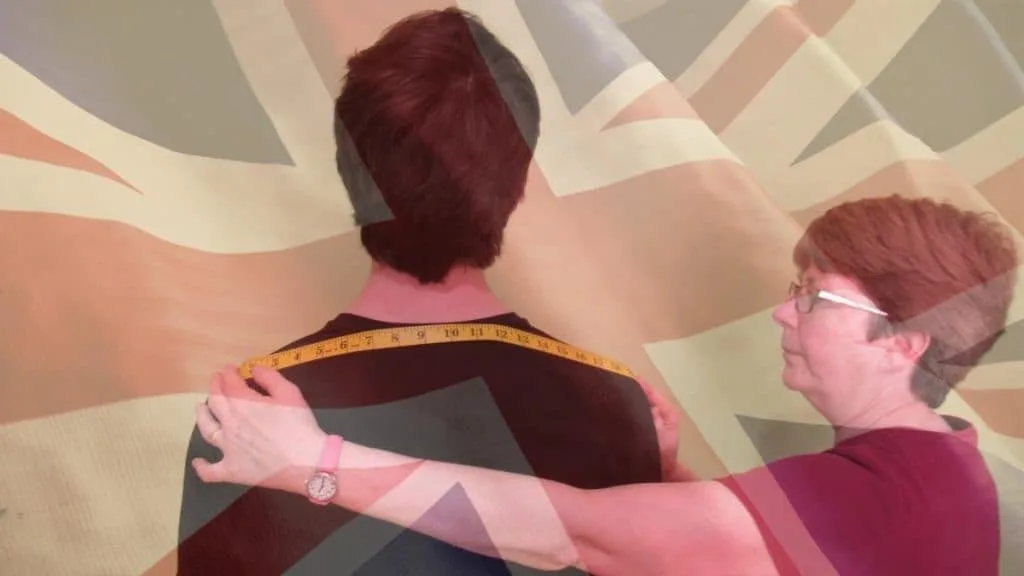
What is the average UK shoulder width? According to 2005 anthropometric data published by the Health and Safety Executive (HSE), the average shoulder width for a person living in the United Kingdom is 19.2 inches or 48.8 cm. [3]
Although this anthropometric data remains some of the highest quality ever produced in the UK—certainly in terms of the variety of anthropometric measurements carried out—there are a few caveats to be made.
Firstly, since the data was taken from British people who work at height (e.g., construction workers, rescue workers, lorry drivers), the vast majority of participants were male, and this is certainly reflected in the 19.2 inch shoulder to shoulder measurement.
Additionally, the biacromial breadth of the participants was measured while they were in their work clothes. As you can see on page 44 of the report, these clothes tend to be bulky and have padding around the shoulders, which is likely to add 2-3 inches to one’s shoulder width.
For this reason, these shoulder width measurements cannot be directly compared with the American measurements listed above or said to be representative of the majority of British women.
Nevertheless, the previously cited US anthropometric data is likely to be highly representative of the British population as well.
Indeed, if you subtract the recommended 2-3 inches from the UK shoulder width data (to account for the bulky clothing), the shoulder width measurements are virtually identical in the UK and in the USA.
What is the average shoulder width for teenagers?

What is the average shoulder width for teenagers? It depends on the age of the teen, but in general, the average shoulder width for male teenagers is between 14.1 inches and 16.1 inches. For female teenagers, the average shoulder length is between 14 inches and 14.3 inches.
Here is a more detailed breakdown by age group.
For 14-year-olds, the normal shoulder width is 14.8 inches for males and 14.2 inches for females.
For 15-year-olds, the average shoulder length measurement is 15.3 inches for boys and 14.3 inches for girls.
For 16-year-olds, the average shoulder measurements are 15.7 inches for boys and 14.4 inches for girls.
For 17-year-olds, the average shoulder breadth is 16.1 inches for boys and 14.4 inches for girls.
For 18-year-olds, the average cross shoulder measurement is 16.1 inches for males and 14.4 inches for females.
Finally, for 19-year-olds, the normal shoulder measurement is 16.1 inches for males, and the normal female shoulder width is 14.3 inches for women of the same age.
What is the average shoulder circumference for men?

What is the average shoulder circumference for men? According to anthropometric data published by the US Army Natick Soldier Research, Development and Engineering Center, the average male shoulder circumference is 46.25 inches or 117.5 cm. [4]
Although this data is based on the measurements of soldiers—who tend to be fitter than average—based on our own data, the 46 inch measurement is fairly representative of the wider male population.
Indeed, we found that most adult males had a shoulder circumference measurement of between 43 inches on the low end and 50 inches on the high end. Also, shoulder circumference tends to increase in relation to height; taller men typically have broader shoulders than shorter men.
What is the average shoulder circumference for women?

What is the average female shoulder circumference? According to data taken from a 2016 study published in the PLOS ONE journal, the average shoulder circumference for adult females is 39.4 inches or 100 cm. [5]
Although this study examined patients with anorexia nervosa, the authors also recorded the average shoulder girth measurement (shoulder circumference) of healthy controls.
The healthy female participants, who had a 39.4 inch shoulder circumference on average, were typically around 21 years old, 5’7″ tall, and had a BMI of 20-21.
Since this group of women was taller than average, it’s likely that there are plenty of women who have a shoulder circumference that measures less than 39 inches.
By the same token, some women naturally have broader shoulders than others (either due to their bone structure, levels of muscle mass, or both), causing them to have a higher than average shoulder circumference for a female.
Compare Your Shoulder Circumference:
- 40 inch shoulders
- 41 inch shoulders
- 42 inch shoulders
- 43 inch shoulders
- 44 inch shoulders
- 45 inch shoulders
- 46 inch shoulders
- 47 inch shoulders
- 48 inch shoulders
- 49 inch shoulders
- 50 inch shoulders
- 51 inch shoulders
- 52 inch shoulders
- 55 inch shoulders
- 60 inch shoulders
Shoulder Width Size Charts By Age
We created a shoulder width size chart for men, women, and also children and adolescents so that you can see how age and gender affect one’s shoulder breadth.
Men’s shoulder width size chart
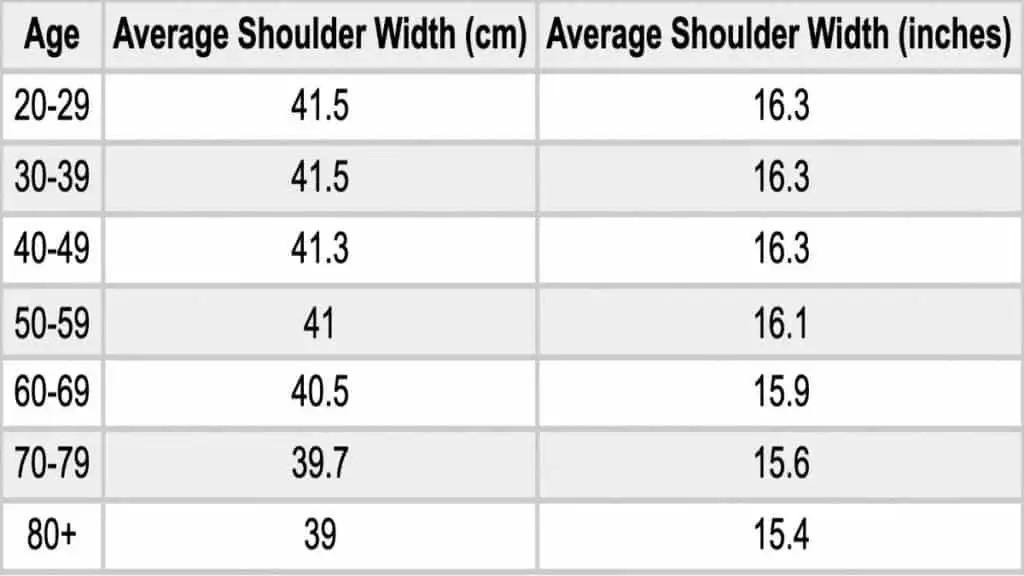
As you can see on this male shoulder size chart, men between the ages of 20 and 49 have the highest shoulder width (16.3 inches).
A middle-aged man (50-59) has a typical shoulder width of 16.1 inches, which is slightly smaller than that of his younger counterparts.
Men aged 60-69 were found to have 15.9-inch shoulders on average, whereas men aged 70-79 had 15.6-inch shoulders. Finally, men aged 80+ had a shoulder measurement of 15.4 inches.
There are two reasons why older men tend to have narrower shoulders than younger men. The first is that the clavicle bones of the older men may have shrunk slightly due to age. [6]
On the other hand, older men may have always had the same shoulder measurement throughout their lives.
It could just be that, in the present day, younger men tend to be taller and have a larger bone structure than older men (their grandparents) due to environmental factors, such as access to higher-quality foods.
Women’s shoulder width size chart
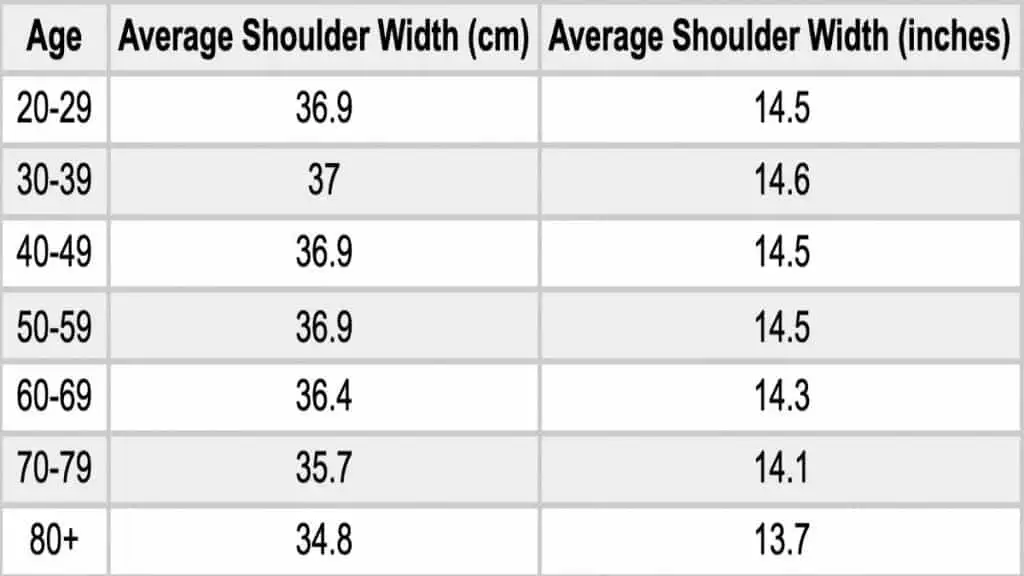
On the above women’s shoulder width size chart, you can see that female shoulder width is very similar across all age groups.
For example, women aged 20-29, 40-49, and 50-59 all had a shoulder-to-shoulder measurement of 14.5 inches.
Women aged 30-39 had a shoulder span of 14.6 inches, whereas women aged 60-69 had an average shoulder length of 14.3 inches.
Older women tend to have a slightly narrower shoulder width measurement than younger females. For example, women aged 70-79 had 14.1-inch shoulders, and women aged 80+ had 13.7-inch shoulders.
These differences could be due to age-related bone shrinkage, and this may well be a factor. But as mentioned above with male shoulder width, the differences in female shoulder width are likely due to the younger generations having a larger bone structure in general. Women are typically taller nowadays.
Male children and adolescent’s shoulder measurement chart
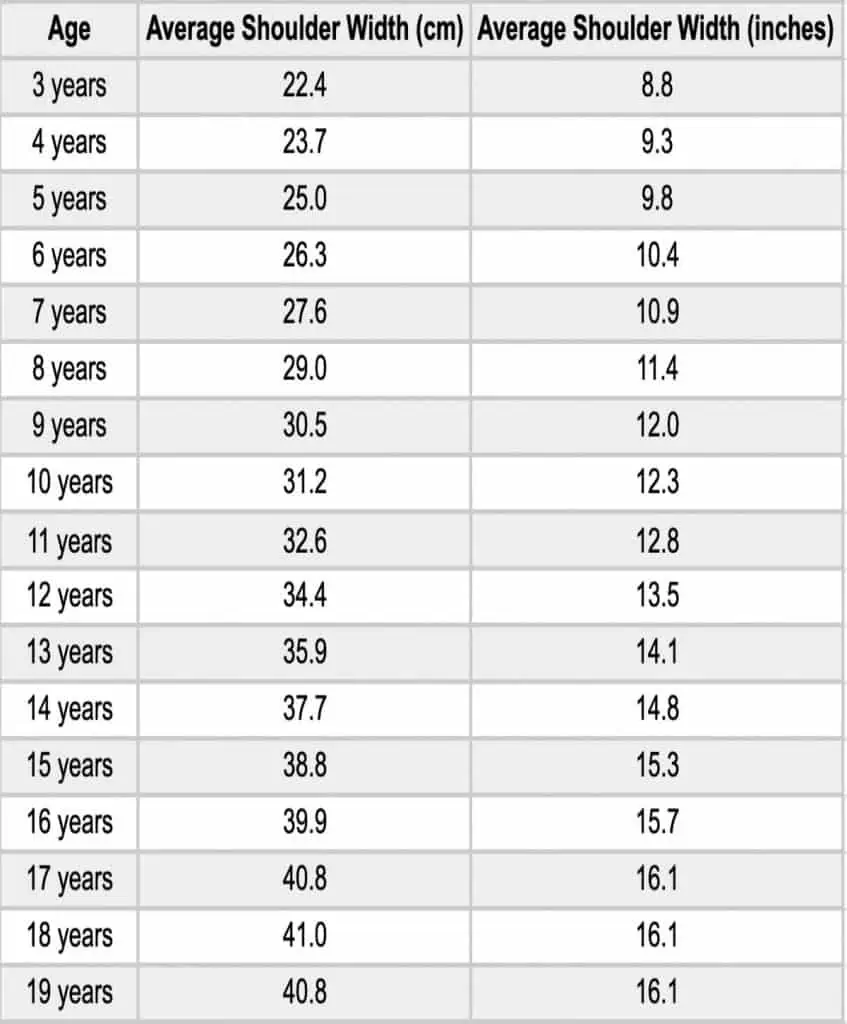
The shoulder measurement chart for children and adolescents is particularly interesting for a few reasons.
First off, up until age 14, you can see that males and females have virtually identical shoulder width measurements, which indicates that boys really begin to broaden out at around age 14, which, conversely, is the age at which teenage girls stop gaining significant amounts of shoulder length.
Female children and adolescent’s shoulder measurement chart
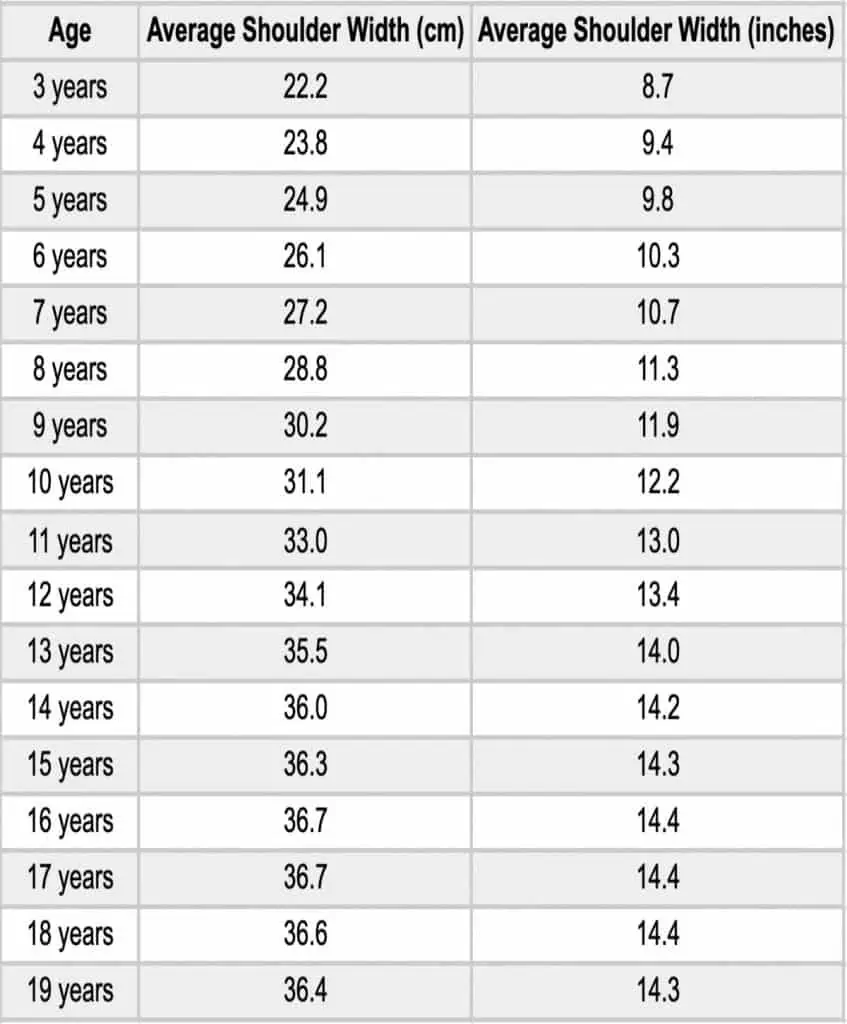
Specifically, for teenage girls, after age 14, females gain only a minuscule amount of shoulder length (14.2 inches to 14.4 inches).
On the other hand, males go from having 14.1-inch shoulders at age 13 to having 16.1-inch shoulders at age 17, a gain of two inches rather than 0.2 inches as with the females.
This data correlates perfectly with research showing when boys and girls attain their peak shoulder measurements. [7]
3 Ways to Measure Your Shoulders
Learning how to measure your shoulders will help you determine the width of your clavicles, the length of your shoulders, and the circumference of your shoulders.
Each of the 3 measuring methods is explained in detail below, and you’ll learn precisely when each method is best used.
How to measure your shoulder width (Biacromial breadth)?
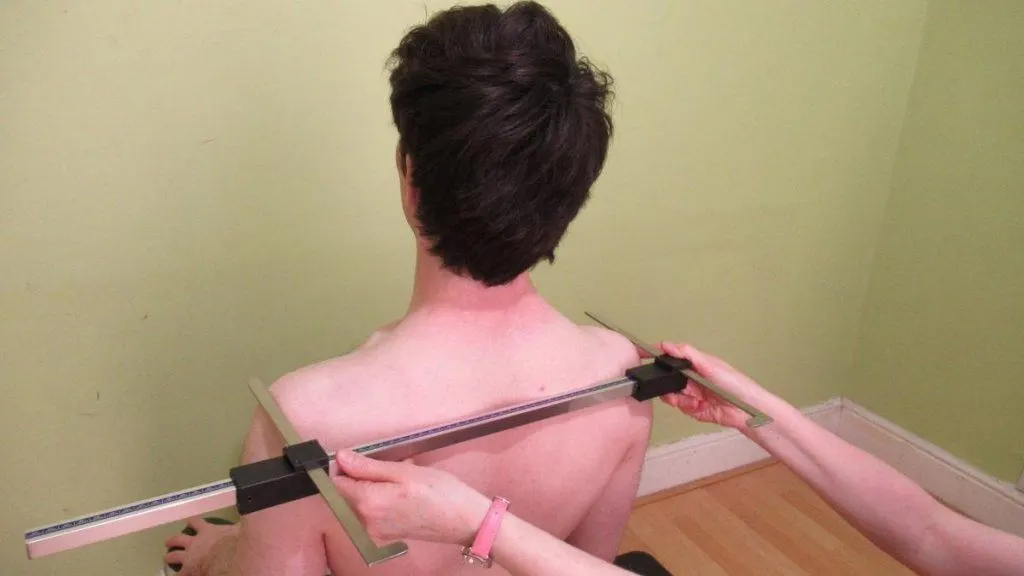
Biacromial breadth is the most frequent shoulder measurement method used in scientific research and anthropometric data collection.
Shoulder breadth refers to the distance (measured in a straight line) between your acromia (the bony parts on the ends of your shoulders).
As such, Biacromial breadth takes into account your bone structure (clavicle width) and not the muscularity of your shoulders.
Biacromial breadth is one of two shoulder width measurements and is best taken with a large bone caliper (also called a large bone anthropometer).
It’s possible to measure your shoulder span with a tape measure if you just want to get a rough idea of your shoulder width. However, for serious research and investigation, professional anthropometric equipment should be used.
How to measure your shoulder length (shoulder size)?

If you want to know how to measure your shoulder width for clothing, this option is for you. Your shoulder length takes into account your clavicle width and your upper back size.
You’ll need a tape measure and another person to take an accurate shoulder width measurement.
- Stand up straight with your arms by your sides.
- Have someone run a tape measure across your upper back (shoulder to shoulder).
- As you are measuring, curve the tape in a slightly upward direction to factor in the size of the upper back.
- Place the ends of the tape measure where the shoulder meets the arm and begins to curve down.
- Record your shoulder width measurement.
How to measure your shoulder circumference?
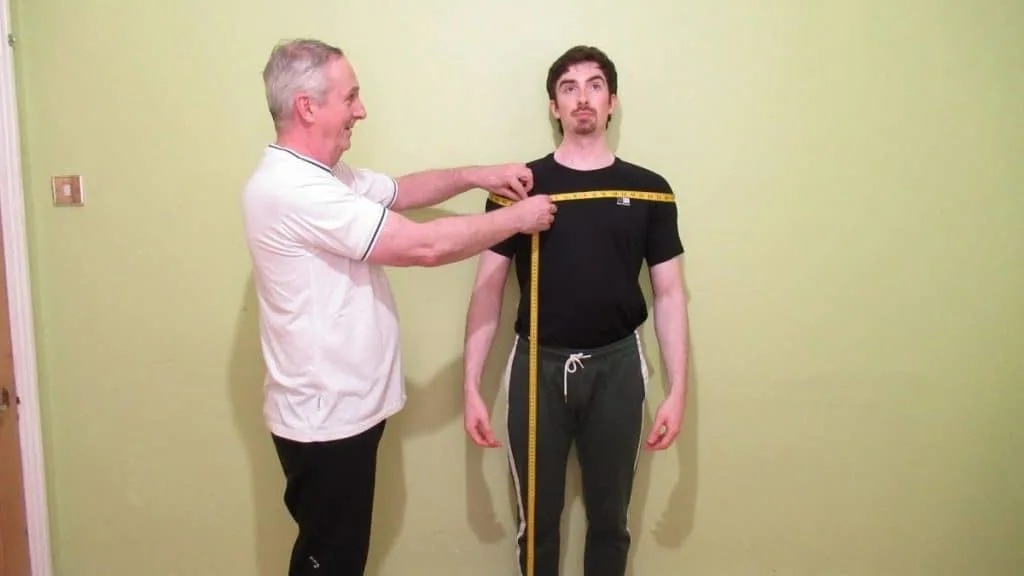
If you want to know how to measure your shoulders to assess your fitness or weight loss progress, the shoulder circumference measurement is your best bet because it takes into account your bone structure, muscle mass, and fat tissue storage.
Here’s how to measure your shoulder circumference with a tape measure.
- Stand up straight with your arms by your sides. Don’t let your shoulders round forward.
- Have someone wrap a tape measure around the broadest part of your shoulders (measure around the actual deltoids, not the upper arms).
- Ensure that the tape is straight.
- Pull the tape measure so that the ends overlap.
- The number where the ends overlap is your shoulder circumference measurement.
How to measure your shoulders without a tape measure?

Now that we’ve gone over the 3 ways to measure your shoulders (clavicle width, shoulder width from the back, and shoulder circumference), it’s time to learn how to measure your shoulders without a measuring tape.
The first option is to grab a pen and then stand against the wall. Then, reach to your left and mark where the end of your shoulder meets the wall. Do the same for your right-hand side.
This option is imperfect because it doesn’t strictly measure shoulder breadth in terms of bone structure or shoulder width from the back. Additionally, you need to mark your wall, which isn’t something that everyone wants to do.
Your other option is to find a flexible material, such as some string, and use this to measure your shoulder circumference.
You simply wrap the string around the widest part of your shoulders and then, with a pen, mark where the two ends meet. Then, you simply measure between these two points with a ruler to get your shoulder circumference.
How to measure your shoulders for bodybuilding?

How do you measure your shoulders for bodybuilding? Contrary to what some people recommend, you should actually measure your shoulder circumference with a tape measure rather than your shoulder width when it comes to bodybuilding.
Shoulder girth measurements enable you to track your gains far more accurately than shoulder width measurements because circumference measurements factor in your body fat, back muscularity, and deltoid development—not just your clavicle width.
Bodybuilders can, of course, measure their Biacromial breadth to determine their bone structure and muscular potential. But if you truly want to measure your bodybuilding progress, circumference measurements are the way to go.
After all, building the biggest shoulders in the world is about more than just clavicle width; you need amazing deltoid development as well.
Where to measure your shoulders?
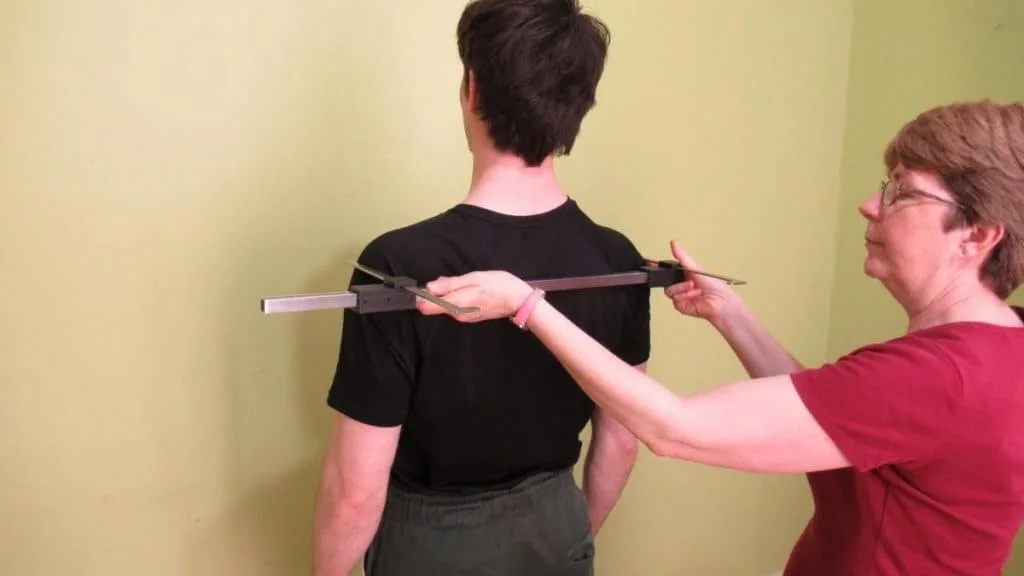
Where should you measure your shoulders? When measuring Biacromial breadth, you should measure between each acromion process on your shoulders (the bony part on the end of your shoulder blade).
When measuring shoulder width from the back, you should measure across the shoulders and upper back, stopping where the shoulders begin to curve down.
When measuring shoulder circumference or shoulder girth, measure around the broadest part of the shoulders and deltoids.
Shoulder Measurement FAQs
Learn everything that there is to know about shoulder width with this helpful FAQ.
How wide should my shoulders be?

The ideal shoulder width depends mainly on your gender and height but also on the appearance that you’re trying to achieve.
If you’re a man with shoulders that are between 15 and 17 inches, then your shoulder length is in the normal range.
For a woman, a shoulder width measurement of 14-15 inches is normal.
Note that these measurements are based on clavicle width. If you measure your shoulders from the back, then your measurement will naturally be larger.
What is the average shoulder width by height?
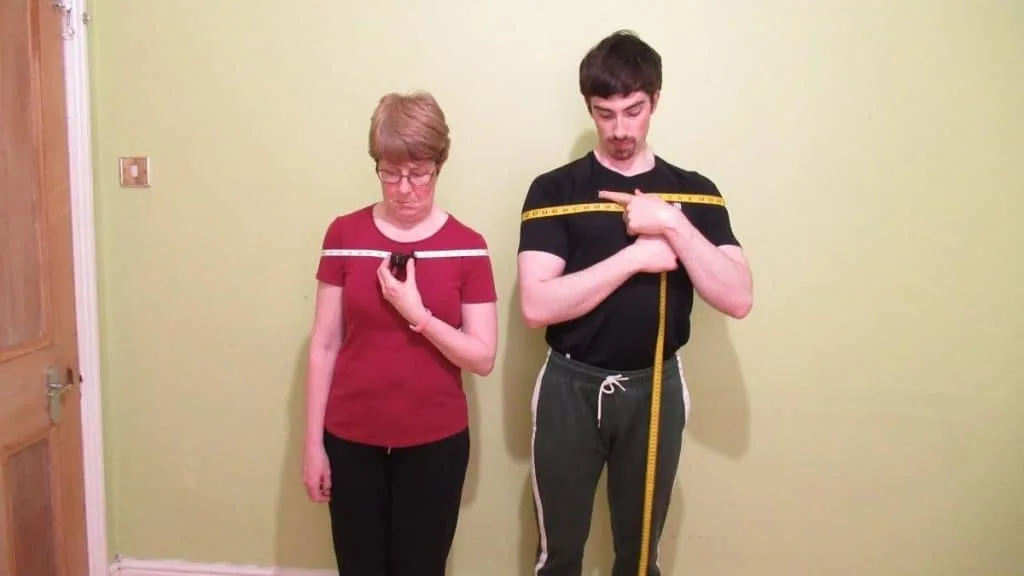
Although there is no good data that examines the average shoulder width by height, we do know that shoulder width tends to increase with height because taller people typically have bigger bone structures (longer clavicles) than shorter individuals.
Of course, it’s possible to be short with wide clavicles, just like it’s possible to be tall with narrow clavicles.
Still, since taller people have longer bones, they almost always have wider shoulders than shorter people.
What is the average shoulder width by age?

Based on the data, younger people tend to have wider shoulders than older people. For example, young men have 16.3-inch shoulders on average, whereas elderly men only have 15.4-inch shoulders.
The reasons for this shoulder size variance are interesting.
On the one hand, the differences in shoulder size could be due to age-related bone loss (but it’s doubtful that would shave a full inch off the clavicles).
More likely, the difference in shoulder length is due to the fact that, at the time of writing, the younger generation is simply much taller than their grandparent’s generation.
As mentioned above, taller people tend to have wider clavicles than shorter people, which likely explains the age-based differences in shoulder size.
What is the average shoulder width for a 6-foot man?

Based on anthropometric research, the average shoulder width for a 6-foot man is between 16 and 17 inches. This measurement is based on shoulder breadth, which doesn’t factor in the upper back muscularity or the size of the deltoids.
When taken from the back, a normal shoulder-to-shoulder measurement for a 6-foot man will be between 18 and 21 inches.
How many heads wide are the shoulders?

How many heads wide are the shoulders? In general, the shoulders are between 2 and 3 heads wide. For women, the shoulders are typically always two heads wide, but for men, especially those with wider clavicles and a more muscular body, the shoulders can definitely be 3 heads wide.
What is the difference between shoulder width and shoulder length?

Just to clarify, shoulder width and shoulder length are the exact same thing and refer to the distance between each acromion on your shoulder blade, otherwise known as Biacromial breadth.
On the other hand, shoulder circumference refers to the girth of your shoulders, which takes into account the size of your clavicles, deltoids, and upper back. Your shoulder circumference will be more than double your shoulder width.
The verdict: Do you have a normal shoulder-to-shoulder measurement?

We’re all built differently. And that’s as true for our shoulder width as it is for our height. But that granted, anthropometric research has been able to shed light on both the average male shoulder width (16.2 inches) and the average female shoulder width (14.4 inches).
It’s also important to note that there are multiple ways to measure your shoulder width, which can make things confusing. For example, most scientific research uses Biacromial breadth, which is based exclusively on bone structure.
On the other hand, most people tend to perform an across-shoulder measurement from behind that takes into account the size of the upper back. So comparing measurements can often lead people to think that their shoulders are much wider or narrower than they really are.
You can, of course, measure your shoulder circumference and girth as well. This measurement takes into account your muscle mass and fat tissue as well as your bone structure and is the preferred choice for tracking your fitness progress.
References
- McDowell MA, Fryar CD, Ogden CL. Anthropometric reference data for children and adults: United States, 1988–1994. National Center for Health Statistics. Vital Health Stat 11(249). 2009
- Tao, Chen & Yang, Rui & Zhanhui, Sun & Weng, Wenguo. (2022). A New Composite Fire Evacuation (Cfe) Model Based On Human Behavior.
- Haines, V., Elton, E., & Hussey, M. (2005). Revision of body size criteria in standards – Protecting people who work at height. Health and Safety Executive. https://www.hse.gov.uk/research/rrpdf/rr342.pdf
- Mitchell, K. B., Choi, H. J., & Garlie, T. N. (2017). Anthropometry And Range Of Motion Of The Encumbered Soldier. U.S. Army Natick Soldier Research, Development and Engineering Center. https://apps.dtic.mil/sti/pdfs/AD1028746.pdf
- Keizer, A., van Elburg, A., Helms, R., & Dijkerman, H. C. (2016). A Virtual Reality Full Body Illusion Improves Body Image Disturbance in Anorexia Nervosa. PLOS ONE, 11(10), e0163921. https://doi.org/10.1371/journal.pone.0163921
- WebMD. (2021, March 19). How Much Do You Shrink As You Age? https://www.webmd.com/healthy-aging/how-much-do-you-shrink-as-you-age
- S. Rao, S. Joshi, A. Kanade. (2000). Growth in some physical dimensions in relation to adolescent growth spurt among rural Indian children. Annals of Human Biology, 27(2), 127–138. https://doi.org/10.1080/030144600282244

